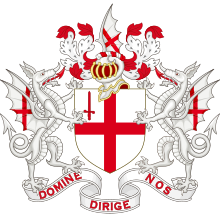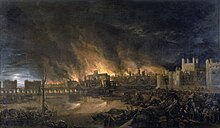Town Clerk of London

The Town Clerk of London is an important position that has existed since the 13th century in the City of London, England. Originally the role was to take the minutes of London council meetings, but over the years the holder's role has gathered responsibility, including staff and executive powers. Historically the incumbent received an annual fee of £10.[1] This has risen to £244,000 in 2016/17, with 55% coming from the City Fund[2] and 40% coming from the City's Cash.[3]
Responsibilities
The Town Clerk of London has been responsible for recording the minutes of the council of the Corporation of London and its committees since 1274.[4] But historically, the Town Clerk of London's role was also one of a legal advisor and recorder of city law. The Town Clerk has worked at the Guildhall in London since 1411. Today the Guildhall is still used for official functions.[5]
The elected City of London council assumed legislative functions and adopted financial powers as confirmed by charters of 1377 and 1383 and as written by a series of Town Clerk of London with the council approval. The council, with the Town Clerk, has amended the civic constitution, regulated the election of Lord Mayor and other officials, and amended the functions of the City of London courts via writs.[6]
These series of changes were successful in expanding the duties of the Town Clerk position and leading to the similar expansion of the City of London courts which had jurisdiction outside London as a type of county court. This gradually took over from the now obsolete circuit criminal court called the Assize Court. The format strongly influenced the development of the High Court of Chancery and Lord Chancellor's jurisdiction based in Westminster.

During the early 17th century, before and after the 1666 Great Fire of London, the Town Clerk's function began to evolve into more complex and multiple roles. The more modern era of the Town Clerk as an executive requires more assistants.
Today the Lord Mayor of the City of London is assisted in his or her day-to-day work by three leading personnel[7] whose titles are the Town Clerk and Chief Executive, the Chamberlain and the Remembrancer.
Town Clerk and Chief Executive
By 2009 the actual title of Town Clerk had resolved into its combined Town Clerk and Chief Executive type position, which is much more than a recorder of minutes of the city council.
As at 2012, The Town Clerk and Chief Executive of the City of London was John Barradell. The Town Clerk's Department manages hundreds of officers and employees of the corporation.[8] He will end his service to the City of London on 31 December 2022 and be replaced by Ian Thomas in February 2023.[9]
Duties[10] include:

- Efficient management and execution of City functions.
- Primary advisor on policy and resources.
- Servicing meetings of the Court of Common Council and designated committees.
- Servicing meetings of the Court of Aldermen and designated committees.
- Investigating complaints against the city.
- Electoral Registration Officer.
- Overseer of public relations.
- Overseer of economic development.
- Overseer of human resources.
The noted Town Clerk of London
John Carpenter was one of the most famous of London's town clerks, and was the author of the first book of English Common Law[11] called "Liber Albus" (the White Book). The statue of John Carpenter, now residing within the City of London School, shows him holding this book.[12] John Carpenter (1372–1442) also in 1442 bequeathed land to the Corporation of London intended to fund the maintenance and education of four boys born within the city, who would be called 'Carpenter's children'. This later became the City of London School.
Town Clerks of London
List of the known Town Clerks of London from 1274 to 2023, covering 749 years[13]
‡ Date of election
| Years served | Name | Notes |
|---|---|---|
| 1274–1306 | Ralph Crepyn, alias 'Ralph de Alegate' | Served as "clericus" or "common clerk" of the city with an absence due to serious injury and Royal inquest from 1285 to 1286 due to the murder of his assailant. |
| 1284–1286 | John de Bauquell, aka Batequell, Banquell and Bankwell | Served from 21 November 1284 to 1286 in absence of Ralph Crepyn. |
| 1307-???? | William [last name unreadable] | aka "clerk de la Gyalle" |
| 1311–1335 | Hugh de Waltham | First known elected Clerk on 20 November 1311. |
| 25/1/1335‡-c. August 1335 | Roger de Depham | Second shortest term in office. |
| 29/8/1335‡–1354 | John de Bourne | |
| 1364?-???? | John Lucas | |
| 7/9/1368‡–1375 | Henry de Padingstone | |
| 10/8/1375‡–1399? | Henry Perot | |
| 1399?–1417 | John Marchaunt | First known to be granted a dwelling and pension (£10 per year) upon retirement. |
| 20/4/1417‡–1438 | John Carpenter | Member of Parliament (MP) 1425, 1437–1439 |
| 4/10/1438‡–1446? | Richard Barnett | |
| 18/11/1446‡–1461 | Roger Spicer, alias Tonge | First known to be dismissed from his office for offences and rebellions against King Edward IV on 5 August 1461. |
| 2/10/1461‡–1490 | William Dunthorn | |
| 9/3/1490‡–1510 | Nicholas Pakenham | |
| 16/7/1510‡–1514 | Walter Stubbe | |
| 20/6/1514‡–1533 | William Paver | First known to have committed suicide while in office |
| 1533–1540 | Thomas Ryshton, or Rysshton | Admitted 13 May 1533, granted annual pension and livery. |
| 1540–1570 | William Blackwell | Admitted 10 July 1540. |
| 1570–1574 | Anthony Stapleton | Admitted 24 July 1570 |
| 1574–1613 | William Sebright | Admitted 25 May 1574. First known to have a deputy (Richard Langley) admitted to assist in office. |
| 1613–1642 | John Weld | Admitted 27 April 1613. His deputy was Robert Michell. He was later knighted for service to the Crown. |
| 1642–1649 | Robert Michell | Succeeded to office 15 September 1642 and confirmed 27 October 1642. First Deputy to assume office when required.[13] |
| 3/7/1649‡–1660 | John Sadler | First known to be suspended from office (on 4 September 1660), then first to have suspension lifted (on 6 September 1660). He is the first known to be declared incapable of continued service (on 18 September 1660) and retired for cause. |
| 1660–1666 | Sir John Weld | Admitted 21 September 1660, first to serve two separate terms of office. His deputy (William Avery) was to succeed him on his death per contract. |
| 1666–1672 | William Avery | Admitted 12 November 1666. |
| 9/2/1672‡–1690 | William Wagstaffe | |
| 1690–1700 | John Goodfellow | Elected 17 February 1690/91 |
| 2/7/1700‡–1705 | Henry Ashurst | |
| 16/11/1705‡–1717 | James Gibson | |
| 9/5/1717‡–1724 | Randolph Stracey | |
| 1724–1737 | Thomas Jackson | Elected 19 March 1723/24 |
| 1737–1757 | Miles Man | First recorded "Clerk" to the Town Clerk to succeed as Town Clerk upon death, he was then elected 13 July 1737. |
| 10/5/1757‡–1774 | Sir James Hodges | Knighted c. 1760. |
| 1774–1801 | William Rix | First known Clerk to the Town Clerk to officiate during vacancy of illness of Town Clerk. He was then elected 25 November 1774 |
| 1801-1801 | Edward Boxley | Former "principal clerk" appointed to fill in during vacancy on 2 September 1801 to 15 December 1801. Shortest term in office |
| 15/12/1801‡–1825 | Henry Woodthorpe, Sr. | First to have his son (Henry Woodthorpe, Jr.) to be his "principal assistant" upon election then to be his appointed deputy on 27 February 1818 |
| 6/10/1825–1842‡ | Henry Woodthorpe, Jr. | First son to succeed his father in office. "The Remembrancer" appointed to officiate during vacancy of Town Clerk |
| 23/6/1842‡–1859 | Henry Alworth Merewether | |
| 10/2/1859‡–1873 | Frederick Woodthorpe | Son of Henry Woodthorpe, Jr.[14] |
| 17/7/1873‡–1902 | Sir John Braddick Monckton | Knighted 1880. The "Remembrancer" appointed to officiate during vacancy of Town Clerk |
| 1/5/1902‡–1935 | Sir James Bell | With effect from 1 June 1902. Knighted 1911 |
| 1935–1946 | Alfred Thomas Roach | Elected 13 June 1935. The "Comptroller and City Solicitor" (Anthony Frederick Ingham Pickford) appointed to officiate during vacancy of Town Clerk from November 1946 |
| 1946–1953 | Sir Anthony Frederick Ingham Pickford | Elected 27 February 1947 with effect from 28 November 1946. Knighted 1949 |
| 1954–1974 | Sir Edward Henry Nichols | Elected 22 October 1953 with effect from 1 January 1954. Knighted June 1982 |
| 1974–1982 | Stanley James Clayton | With effect 1 April 1974 |
| 1982–1991 | Geoffrey William Rowley | With effect 2 September 1982 |
| 1991–1995 | Samuel Jones | With effect 23 May 1991 |
| 1996–1999 | Bernard Peter Harty | No election date given |
| 1999–2003 | Tom Christopher Simmons | No election date given. Former Deputy Town Clerk |
| 2003–2012 | Chris Duffield | Served from September 2003 to 2012. |
| 2012–2022 | John Barradell | Served February 2012 to 31 December 2022. Formerly Chief Executive of Brighton & Hove City Council and Deputy Chief Executive of Westminster City Council. |
| 2023–present | Ian Thomas | Appointed effective February 2023. Former Chief Executive of the Royal Borough of Kingston upon Thames.[9] |
References
- ^ Allen, Thomas (1828). The History and Antiquities of London, Westminster, Southwark and Parts Adjacent. With Engravings. (Vol. 1-4 by T. Allen; Vol. 5 by T. Wright.). G. Virtue. Retrieved 21 December 2017.
- ^ "City Fund Statement of Accounts 2016/17" (PDF). www.cityoflondon.gov.uk. City of London Corporation. Retrieved 21 December 2017.
- ^ "City's Cash Annual Report and Financial Statement" (PDF). www.cityoflondon.gov.uk. City of London Corporation. Retrieved 21 December 2017.
- ^ Court of Common Council: Administrative/Biographical history. See: http://www.aim25.ac.uk/cgi-bin/vcdf/detail?coll_id=11567&inst_id=118&nv1=search&nv2=
- ^ "The Guildhall", Museum of London.
- ^ Court of Common Council: Administrative/Biographical history.
- ^ Leading personnel page at: http://www.cityoflondon.gov.uk/Corporation/LGNL_Services/Council_and_democracy/Council_departments/Leading+personnel.htm Archived 25 December 2010 at the Wayback Machine -
- ^ City of London Corporation – See: "Departmental structure". Archived from the original on 25 December 2010. Retrieved 25 October 2010.
- ^ a b https://www.citymatters.london/city-corporation-appoints-new-town-clerk-and-chief-executive/, retrieved 27 November 2022, City Matters - London, dated 18 November 2022.
- ^ City of London – Leading personnel – http://www.cityoflondon.gov.uk/Corporation/LGNL_Services/Council_and_democracy/Council_departments/Leading+personnel.htm#townclerk Archived 25 December 2010 at the Wayback Machine
- ^ Medieval English common law: foundations for 21st century legal systems. See: English Common Law#Medieval English common law: foundations for 21st century legal systems
- ^ Riley, Henry T., and John Carpenter, eds. Munimenta Gildhallae Londoniensis; Liber Albus, Liber Custumarum, Et Liber Horn. 3 Vols. in 4. Rerum Britannicarum Medii Aevi Scriptores (Rolls Series), 12. London: Longman, Brown, Green, Longmans, and Roberts, 1859–1862. City of London (England), Henry T. Riley, and John Carpenter. Munimenta Gildhallæ Londoniensis: Liber albus, Liber custumarum, et Liber Horn. London: Longman, Brown, Green, Longmans, and Roberts, 1859.
- ^ a b Libraries, Archives and Guildhall Art Gallery, "The Town Clerk" – Pages 71–74, from the London Metropolitan Archives, City of London, 40 Northampton Road, London EC 1R 0HB – www.cityoflondon.gov.uk – www.lma.gov.uk – additional information supplied by the Director of Libraries, Archives and Guildhall Gallery, David Bradbury, BA, MA, DipLib, MCLIP.
- ^ Cave, Edward; Nichols, John (1842). The Gentleman's Magazine, and Historical Chronicle, for the Year ... Edw. Cave, 1736-[1868]. p. 557. Retrieved 21 December 2017.
External links
- City of London website
- City of London School web site
- City of London Corporation – Town Clerk & Chief Executive picture at: https://web.archive.org/web/20101225080704/http://www.cityoflondon.gov.uk/Corporation/LGNL_Services/Council_and_democracy/Council_departments/
- Guildhall – https://web.archive.org/web/20080513213124/http://www.cityoflondon.gov.uk/Corporation/LGNL_Services/Leisure_and_culture/Local_history_and_heritage/Buildings_within_the_City/guildhall.htm City of London Corporation homepage on the Guildhall.
